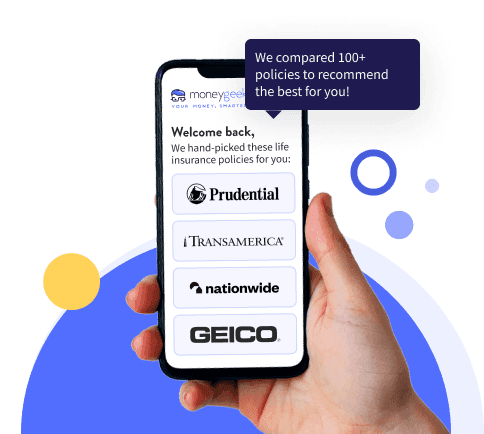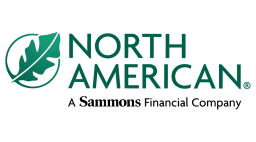The best universal life insurance combines lifelong coverage with flexible premiums, cash value growth, and customizable death benefits. In 2025, MoneyGeek ranks North American, Protective Insurance, Ethos and Midland National as the top universal life insurance companies. These providers stand out for their financial strength, flexible policy options, and customer satisfaction.
Best Universal Life Insurance Companies in 2025
North American, Protective Insurance, Ethos and Midland National offer the best universal life insurance based on MoneyGeek's analysis, but the right option depends on your needs.
Find out if you're overpaying for life insurance below.

Updated: December 2, 2025
Advertising & Editorial Disclosure
Universal life insurance provides lifelong coverage with flexible premiums and a cash value component, making it suitable for long-term financial planning.
North American is the best universal life insurance company overall. It also ranks first for seniors, smokers and people who are overweight.
The top-rated insurer for people in poor health is Protective Insurance. Ethos stands out for indexed universal life insurance. Meanwhile, Midland National is the best cheap universal life insurance company.
Ensure you are getting the best rate for your insurance. Compare quotes from the top insurance companies.
What is the Best Universal Life Insurance?
North American | 5 | $295 (men) $252 (women) | $3,535 (men) $3,016 (women) | |
Protective Insurance | 5 | $317 (men) $275 (women) | $3,804 (men) $3,302 (women) | |
Ethos | 5 | $328 (men) $275 (women) | $3,935 (men) $3,297 (women) | |
Midland National | 4.5 | $295 (men) $251 (women) | $3,535 (men) $3,016 (women) |
Rates based on averages from MoneyGeek's 2025 life insurance survey for nonsmokers with average weight and health ratings. Actual premiums may vary significantly depending on your individual profile, health status, coverage needs and insurer underwriting guidelines. Rates shown are for illustrative purposes only.
Best Overall: North American

Average Monthly Cost
$295 (men); $252 (women)Average Annual Cost
$3,535 (men); $3,016 (women)
- pros
Strong A+ ratings for financial strength
Competitive monthly rates
Wide selection of policies
consOnline applications not available for universal life
Must work with an agent for policy purchase
North American ranks as the best universal life insurance provider overall. It combines affordability with several policy options. Average monthly costs are $295 for adult men and $252 for adult women.
- J.D. Power Rating: N/A
- AM Best Rating: A+
- BBB Rating: A+
- Average NAIC Complaint Index: N/A
- Customer sentiment: 77% positive, 23% negative
Best for People in Poor Health: Protective Insurance

Average Monthly Cost
$317 (men); $275 (women)Average Annual Cost
$3,804 (men); $3,302 (women)
- pros
Affordable rates for high-risk applicants
Strong financial stability with A+ AM Best rating
consMedical exam required for universal life coverage
Online quotes limited to term life policies
Protective Insurance is the best company for universal life insurance if you have poor health. It provides affordable rates and reliable long-term coverage.
Average monthly costs are $317 for men and $275 for women in poor health, or about $3,804 and $3,302 annually.
- J.D. Power Rating: 653 (9th place)
- A.M. Best Rating: A+
- BBB Rating: N/A
- Average NAIC Complaint Index: N/A
- Customer sentiment: 82% positive, 18% negative
Best Indexed Universal Life Insurance Company: Ethos

Average Monthly Cost
$328 (men); $275 (women)Average Annual Cost
$3,935 (men); $3,297 (women)
- pros
Fully digital application with quick approval process
Free riders for accelerated benefits and planning tools
Strong ratings: A+ BBB and A+ AM Best
consPolicies underwritten by partner insurers
Coverage options vary by state
Ethos is ranked as the best indexed universal life insurance company. Average monthly premiums are $328 for men and $275 for women.
Ethos has a fully online application process.
- J.D. Power: N/A
- AM Best Rating: A+
- BBB Rating: A+
- Average NAIC Complaint Index: N/A
- Customer sentiment: 95.33% positive, 4.67% negative
Best Cheap: Midland National

Average Monthly Cost
$295 (men); $251 (women)Average Annual Cost
$3,535 (men); $3,016 (women)
- pros
Strong financial strength with A+ AM Best rating
Wide selection of riders for flexible coverage
consOnline quotes available only for term policies
Must apply through an agent for universal life
Midland National is MoneyGeek's pick for the best cheap universal life insurance company for offering strong financial stability and affordable coverage. Average monthly premiums are $295 for adult men and $251 for adult women, making it a cost-effective option for lifelong financial protection.
With more than 115 years in the industry, Midland National provides universal life, indexed universal life and variable universal life insurance. Policyholders can enhance their coverage with riders such as accidental death, guaranteed insurability and overloan protection. Midland National also earned a J.D. Power rating of 643 and an A+ AM Best Rating.
- J.D. Power: 643 (13th)
- BBB Rating: A+
- A.M. Best Rating: A+
- Average NAIC Complaint Index: N/A
- Customer sentiment: 72% positive, 28% negative
How Does Universal Life Insurance Work?
A universal life insurance policy provides permanent life insurance coverage. It pays a death benefit to your beneficiary and includes a cash value savings component. This cash value grows over time and can be used to fund premiums, take out loans or make withdrawals. You’ll receive the cash value minus surrender charges if you surrender the policy.
- Traditional universal life: Offers flexible premiums and death benefits with cash value that earns interest.
- Indexed universal life insurance (IUL): Ties cash value growth to a stock market index like the S&P 500.
- Variable universal life (VUL): Allows you to invest cash value in mutual fund-like subaccounts for potentially higher returns but with greater market risk.
- Guaranteed universal life (GUL): Provides lifetime coverage with lower premiums and minimal cash value.
How to Choose the Best Universal Life Insurance Policy
- 1Financial strength ratings
Choose companies with AM Best ratings of A or higher.
- 2Policy flexibility
Look for options to adjust death benefits and premiums as your financial situation changes.
- 3Cash value growth potential
Compare interest rates, crediting methods and fee structures that affect how quickly your cash value accumulates.
- 4Rider availability
Look at options like accelerated death benefits, chronic illness riders and guaranteed insurability options.
- 5Customer service quality
Review complaint ratios from state insurance departments and customer satisfaction scores from J.D. Power.
- 6Premium costs
Get quotes from multiple insurers.
How Much Does Universal Life Insurance Cost?
Life insurance costs depend on factors like age, lifestyle, health and coverage amount. Because universal life combines lifelong financial protection with a cash value component, premiums are generally higher than term life but offer more flexibility and long-term value. Rates also differ depending on whether you choose a standard or indexed universal policy, as well as any riders you add for additional financial protection.
The tables provide average costs based on gender, age, and coverage amount:
| $100,000 | $59 | $706 |
| $250,000 | $147 | $1,764 |
| $500,000 | $294 | $3,528 |
| $750,000 | $441 | $5,292 |
| $1,000,000 | $588 | $7,056 |
| $2,500,000 | $1,470 | $17,640 |
The rates above are based on averages for nonsmokers with average weight and health ratings. Actual premiums may vary depending on your profile and coverage needs.
Universal Life Insurance FAQs
We answer common questions about universal life insurance to help you determine the best policy for your needs.
What are the pros of universal life insurance?
Universal life insurance pros include lifetime coverage with flexibility in the death benefit and premiums. You can build cash value, and some policies offer features like a no-lapse guarantee and minimum interest rate guarantees. You can use the cash value to pay premiums, make withdrawals, take out a loan or cash out the policy if you no longer need coverage.
What are the cons of universal life insurance?
Universal life insurance cons include requiring active management because universal life insurance isn't a "set it and forget it" policy, especially for policies without guarantees. Poor market returns could lead to higher premiums to keep the policy active. Building cash value takes time and may not perform as well as other investments. If the policy isn't regularly monitored, underfunding risk can cause the policy to lapse.
Is universal life insurance worth it?
Universal life insurance is worth it for those seeking lifetime coverage with flexible premiums and the potential to accumulate cash value, depending on their financial goals and needs.
Can I borrow against my universal life insurance policy?
You can take policy loans against your universal life insurance cash value, typically borrowing up to 90% of the cash surrender value. Policy loans accrue interest at rates set by the insurance company, usually 4% to 8% annually. Borrowed amounts reduce the death benefit dollar-for-dollar. Unpaid loans plus interest can cause policy lapses if loans exceed the cash value.
What's the difference between universal and whole life insurance?
Universal life insurance offers flexible premiums and death benefits you can adjust over time, while whole life insurance has fixed premiums and guaranteed cash value growth. Universal life gives you more control but requires active management, whereas whole life provides predictable, lifelong coverage with less flexibility.
Our Review Methodology
Universal life insurance shopping means sifting through dozens of companies, each promising competitive rates and flexible coverage. The challenge isn't finding options; it's identifying which insurers actually deliver affordable premiums, reliable claims processing, and the policy flexibility that drew you to universal life in the first place.
We designed our research to cut through marketing claims and focus on what actually matters when you're comparing universal life policies. Our analysis examined 248,399 life insurance quotes alongside customer satisfaction data, financial stability reports, and product offerings to identify which companies deliver the best combination of value and reliability.
Our Scoring Framework
MoneyGeek ranked the top universal life insurance companies using the following weightings:
- Affordability (55%)
- Customer Experience (30%)
- Coverage Options (15%)
Each company's final score incorporates cost data from online quotes, AM Best financial strength ratings, years in business, NAIC customer complaint index data, and availability of tools like online account management and flexible payment options.
Sample Customer Profile
Unless otherwise stated, the rates shown in this article use this standard profile:
- 30- to 49-year-old
- Nonsmoker
- 5'9" tall, 160 pounds for male
- 5'4" tall, 120 pounds for female
- Average health rating
- $500,000 coverage
We modified this baseline profile by age, health status, weight and smoking status to capture rate variations across different customer types. This approach revealed pricing patterns that helped us project costs for various demographics and identify which companies consistently offer competitive rates.
The data trends we identified allow us to extend our analysis beyond the original quote collection, giving you insights into how premiums might change as your circumstances evolve.
Related Articles
About Mark Fitzpatrick

Mark Fitzpatrick, a Licensed Property and Casualty Insurance Producer, is MoneyGeek's resident Personal Finance Expert. With over five years of experience analyzing the insurance market, he conducts original research and creates tailored content for all types of buyers. His insights have been featured in publications like CNBC, NBC News and Mashable.
Fitzpatrick holds a master’s degree in economics and international relations from Johns Hopkins University and a bachelor’s degree from Boston College. He's also a five-time Jeopardy champion!
He writes about economics and insurance, breaking down complex topics so people know what they're buying.






